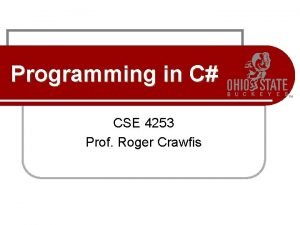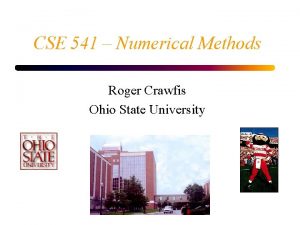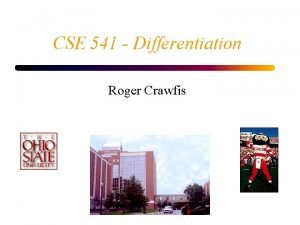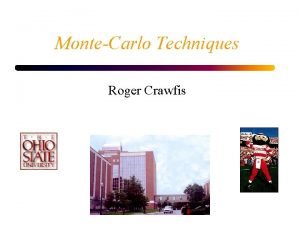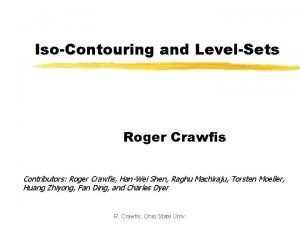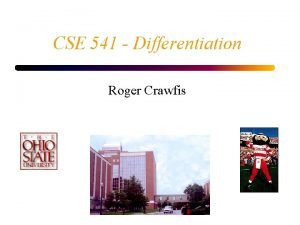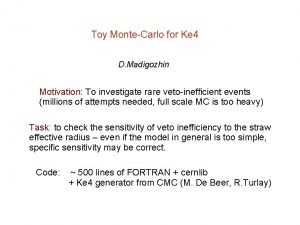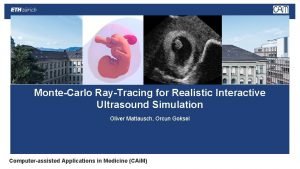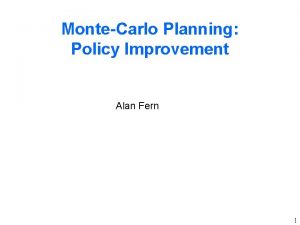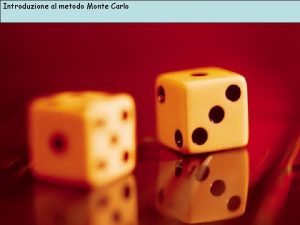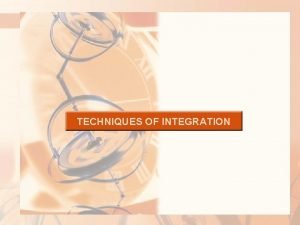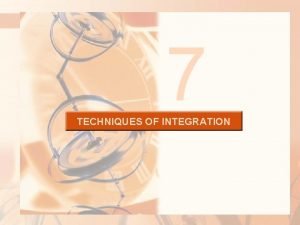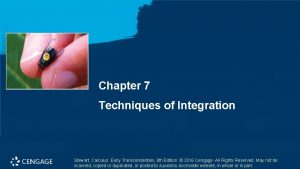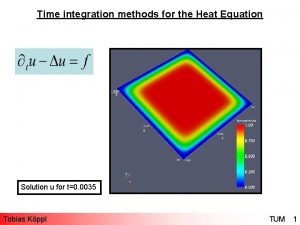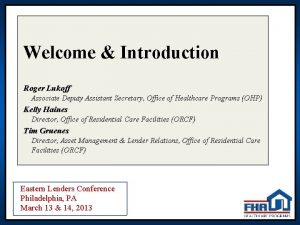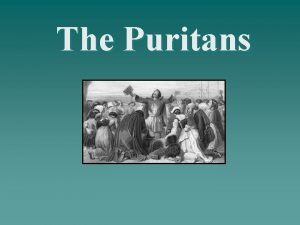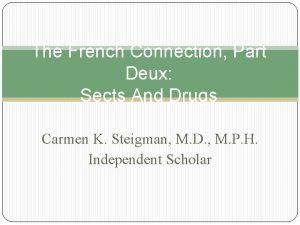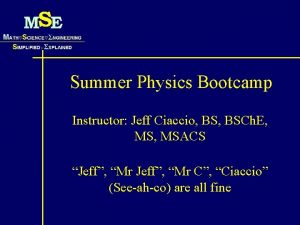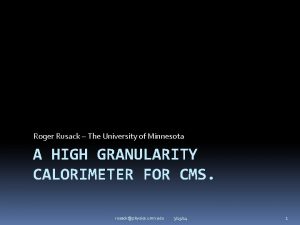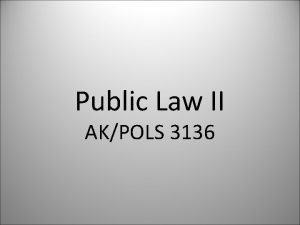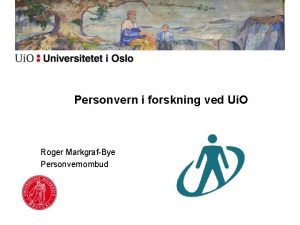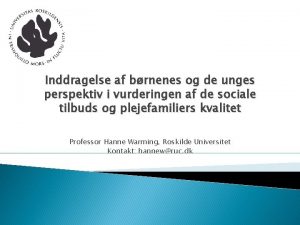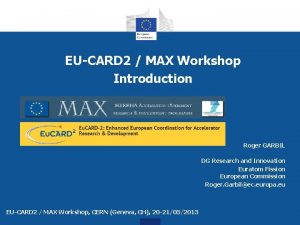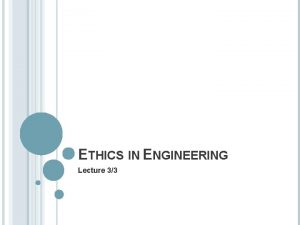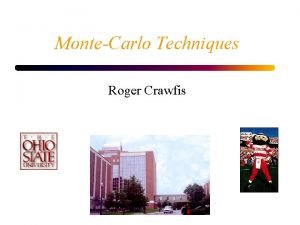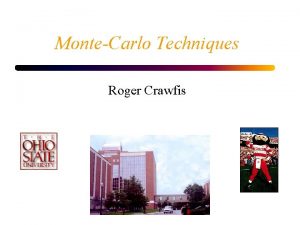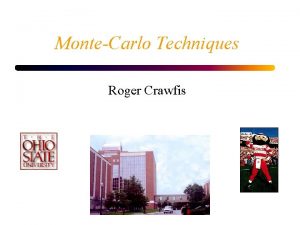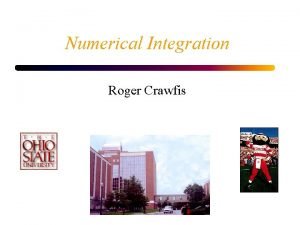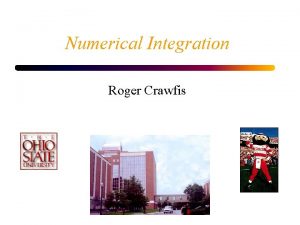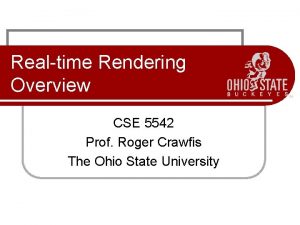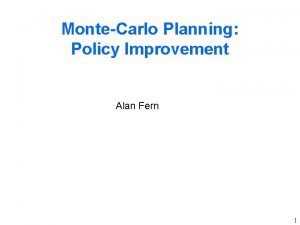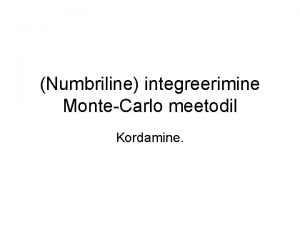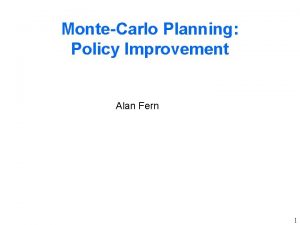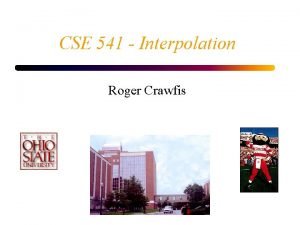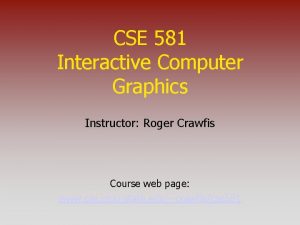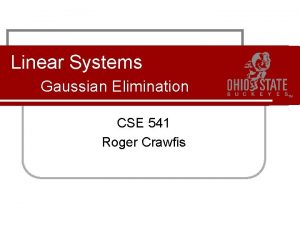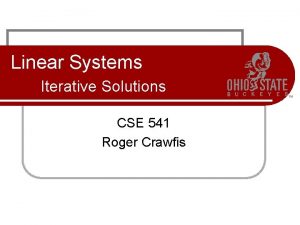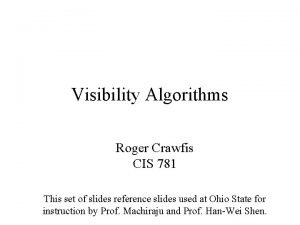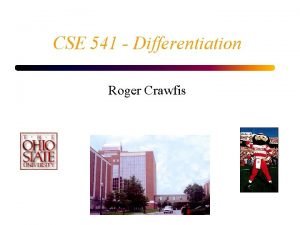MonteCarlo Techniques Roger Crawfis MonteCarlo Integration Overview 1













































- Slides: 45

Monte-Carlo Techniques Roger Crawfis

Monte-Carlo Integration • Overview 1. Generating Psuedo-Random Numbers 2. Multidimensional Integration a) Handling complex boundaries. b) Handling complex integrands. 28 February 2021 OSU/CIS 541 2

Pseudo-Random Numbers • Definition of random from Merriam-Webster: • Main Entry: random Function: adjective Date: 1565 1 a : lacking a definite plan, purpose, or pattern b : made, done, or chosen at random <read random passages from the book> 2 a : relating to, having, or being elements or events with definite probability of occurrence <random processes> b : being or relating to a set or to an element of a set each of whose elements has equal probability of occurrence <a random sample>; also : characterized by procedures designed to obtain such sets or elements <random sampling> 28 February 2021 OSU/CIS 541 3

Random Computer Calculations? • Compare this to the definition of an algorithm (dictionary. com): – algorithm • n : a precise rule (or set of rules) specifying how to solve some problem. 28 February 2021 OSU/CIS 541 4

Random Number • What is random number ? Is 3 ? – There is no such thing as single random number • Random number – A set of numbers that have nothing to do with the other numbers in the sequence • In a uniform distribution of random numbers in the range [0, 1] , every number has the same chance of turning up. – 0. 00001 is just as likely as 0. 5000 28 February 2021 OSU/CIS 541 5

Random v. Pseudo-random • Random numbers have no defined sequence or formulation. Thus, for any n random numbers, each appears with equal probability. • If we restrict ourselves to the set of 32 -bit integers, then our numbers will start to repeat after some very large n. The numbers thus clump within this range and around these integers. • Due to this limitation, computer algorithms are restricted to generating what we call pseudorandom numbers. 28 February 2021 OSU/CIS 541 6

Monte-Carlo Methods • 1953, Nicolaus Metropolis • Monte Carlo method refers to any method that makes use of random numbers – Simulation of natural phenomena – Simulation of experimental apparatus – Numerical analysis 28 February 2021 OSU/CIS 541 7

How to generate random numbers ? • Use some chaotic system (Balls in a barrel – Lotto) • Use a process that is inherently random – Radioactive decay – Thermal noise – Cosmic ray arrival • Tables of a few million random numbers • Hooking up a random machine to a computer. 28 February 2021 OSU/CIS 541 8

Pseudo Random number generators • The closest random number generator that can be obtained by computer algorithm. • Usually a uniform distribution in the range [0, 1] • Most pseudo random number generators have two things in common – The use of large prime numbers – The use of modulo arithmetic • Algorithm generates integers between 0 and M, map to zero and one. 28 February 2021 OSU/CIS 541 9

An early example (John Von Neumann, 1946) • To generate 10 digits of integer – Start with one of 10 digits integers – Square it and take middle 10 digits from answer – Example: 57721566492 = 33317792380594909291 • The sequence appears to be random, but each number is determined from the previous not random. • Serious problem : Small numbers (0 or 1) are lumped together, it can get itself to a short loop. For example: • • 61002 = 37210000 21002 = 04410000 41002 = 16810000 51002 = 65610000 28 February 2021 OSU/CIS 541 10

Linear Congruential Method • Lehmer, 1948 • Most typical so-called random number generator • Algorithm : – a, c >=0 , m > I 0, a, c • Advantage : – Very fast • Problem : – Poor choice of the constants can lead to very poor sequence – The relationship will repeat with a period no greater than m (around m/4) • C complier RAND_MAX : m = 32767 28 February 2021 OSU/CIS 541 11

RANDU Generator • 1960’s IBM • Algorithm • This generator was later found to have a serious problem 28 February 2021 OSU/CIS 541 12

1 D and 2 D Distribution of RANDU 28 February 2021 OSU/CIS 541 13

Random Number Algorithms • The class of multiplicative congruential random-number generators has the form: . The choice of the coefficients is critical. Example in book: 28 February 2021 OSU/CIS 541 14

Use of Prime Numbers • The number 231 – 1 is a prime number, so the remainder when a number is divided by a prime is rather, well random. • Notes on the previous algorithm: – The l’s can reach a maximum value of the prime number. – Dividing by this number maps the integers into reals within the open interval (0, 1. 0). • Why open interval? – l 0 is called the seed of the random process. We can use anything here. 28 February 2021 OSU/CIS 541 15

Other Algorithms • Multiply by a large prime and take the lower-order bits. • Here, we use higherbit integers to generate 48 -bit random numbers. • Drand 48() 28 February 2021 OSU/CIS 541 16

Other Algorithms • Many more such algorithms. t is any large number What is this operation? • Some do not use integers. Integers were just more efficient on old computers. 28 February 2021 OSU/CIS 541 17

Other Algorithms • One way to improve the behavior of random number generator Has two initial seed and can have a period greater than m 28 February 2021 OSU/CIS 541 18

The RANMAR generator • Available in the CERN Library – Requires 103 initial seed – Period : about 1043 – This seems to be the ultimate random number generator 28 February 2021 OSU/CIS 541 19

Properties of Pseudo-Random Numbers • Three key properties that you should remember: 1. These algorithms generate periodic sequences (hence not random). To see this, consider what happens when a random number is generated that matches our initial seed. 28 February 2021 OSU/CIS 541 20

Properties of Pseudo-Random Numbers 2. The restriction to quantized numbers (a finiteset), leads to problems in high-dimensional space. Many points end up to be co-planar. For ten-dimensions, and 32 -bit random numbers, this leads to only 126 hyper-planes in 10 -dimensional space. 28 February 2021 OSU/CIS 541 21

3 D Distribution from RANDU Problems seen when observed at the right angle 28 February 2021 OSU/CIS 541 22

The Marsaglia effect • 1968, Marsaglia • Randon numbers fall mainly in the planes • The replacement of the multiplier from 65539 to 69069 improves performance significantly 28 February 2021 OSU/CIS 541 23

Properties of Pseudo-Random Numbers 3. The individual digits in the random number may not be independent. There may be a higher probability that a 3 will follow a 5. 28 February 2021 OSU/CIS 541 24

Available functions • Standard C Library – Type in “man rand” on your CIS Unix environment. • Rather poor pseudo-random number generator. • Only results in 16 -bit integers. • Has a periodicity of 2**31 though. – Type in “man random” on your CIS Unix environment. • • Slightly better pseudo-random number generator. Results in 32 -bit integers. Used rand() to build an initial table. Has a periodicity of around 2**69. – #include <stdlib. h> 28 February 2021 OSU/CIS 541 25

Available functions • Drand 48() – returns a pseudo-random number in the range from zero to one, using double precision. – Pretty good routine. – May not be as portable. 28 February 2021 OSU/CIS 541 26

Initializing with Seeds • Most of the algorithms have some state that can be initialized. Many times this is the last generated number (not thread safe). • You can set this state using the routines initialization methods (srand, srandom or srand 48). – Why would you want to do this? 28 February 2021 OSU/CIS 541 27

Initializing with Seeds • Two reasons to initialize the seed: 1. The default state always generates the same sequence of random numbers. Not really random at all, particularly for a small set of calls. Solution: Call the seed method with the lower-order bits of the system clock. 2. You need a deterministic process that is repeatable. 28 February 2021 OSU/CIS 541 28

Initializing with Seeds • We do not want the mountain to change as the camera moves. 28 February 2021 OSU/CIS 541 29

Mapping random numbers • Most computer library support for random numbers only provides random numbers over a fixed range. • You need to map this to your desired range. • Two common cases: – Random integers from zero to some maximum. – Random floating-point or double-precision numbers mapped to the range zero to one. 28 February 2021 OSU/CIS 541 30

Non-rectangular Areas • In 2 D, we may want points randomly distributed over some region. – Square – independently determine x and y. – Rectangle - ? ? ? – Circle - ? ? ? • Wrong way – independently determine r and q. 28 February 2021 OSU/CIS 541 31

Monte-Carlo Techniques • Problem: What is the probability that 10 dice throws add up exactly to 32? • Exact Way. Calculate this exactly by counting all possible ways of making 32 from 10 dice. • Approximate (Lazy) Way. Simulate throwing the dice (say 500 times), count the number of times the results add up to 32, and divide this by 500. • Lazy Way can get quite close to the correct answer quite quickly. 28 February 2021 OSU/CIS 541 32

Monte-Carlo Techniques • Sample Applications – Integration – System simulation – Computer graphics - Rendering. – Physical phenomena - radiation transport – Simulation of Bingo game – Communications - bit error rates – VLSI designs - tolerance analysis 28 February 2021 OSU/CIS 541 33

Simple Example: . • Method 1: Analytical Integration • Method 2: Quadrature • Method 3: MC -- random sampling the area enclosed by a<x<b and 0<y<max (p(x)) P(x) a 28 February 2021 b x OSU/CIS 541 a b 34

Simple Example: . • Intuitively: 28 February 2021 OSU/CIS 541 35

Shape of High Dimensional Region • Higher dimensional shapes can be complex. • How to construct weighted points in a grid that covers the region R ? Problem : mean-square distance from the origin 28 February 2021 OSU/CIS 541 36

Integration over simple shape ? Grid must be fine enough ! 28 February 2021 OSU/CIS 541 37

Monte-Carlo Integration D’: rectangular • Integrate a function over a complicated domain – D: complicated domain. – D’: Simple domain, superset of D. • Pick random points over D’: • Counting: N: points over D • N’: points over D’ D D’: circle D 28 February 2021 OSU/CIS 541 38

Estimating p using Monte Carlo • The probability of a random point lying inside the unit circle: (x, y) M • If pick a random point N times and M of those times the point lies inside the unit circle: • If N becomes very large, 28 February 2021 N P=P 0 OSU/CIS 541 39

Estimating p using Monte Carlo • Results: –N= 10, 000 – N = 100, 000 – N = 1, 000 – N = 10, 000 –… 28 February 2021 Pi= 3. 104385 Pi= 3. 139545 Pi= 3. 139668 Pi= 3. 141774 OSU/CIS 541 40

Estimating p using Monte Carlo double x, y, pi; const long m_n. Max. Samples = 10000; long count=0; for (long k=0; k<m_n. Max. Samples; k++) { x=2. 0*drand 48() – 1. 0; // Map to the range [-1, 1] y=2. 0*drand 48() – 1. 0; if (x*x+y*y<=1. 0) count++; } pi=4. 0 * (double)count / (double)m_n. Max. Samples; 28 February 2021 OSU/CIS 541 41

Standard Quadrature • We can find numerical value of a definite integral by the definition: where points xi are uniformly spaced. 28 February 2021 OSU/CIS 541 42

Error in Quadrature • Consider integral in d dimensions: • The error with N sampling points is 28 February 2021 OSU/CIS 541 43

Monte Carlo Error • From probability theory one can show that the Monte Carlo error decreases with sample size N as independent of dimension d. 28 February 2021 OSU/CIS 541 44

General Monte Carlo • If the samples are not drawn uniformly but with some probability distribution P(X), we can compute by Monte Carlo: Where P(X) is normalized, 28 February 2021 OSU/CIS 541 45
 Roger crawfis
Roger crawfis Cse 541
Cse 541 Numerical differentiation
Numerical differentiation Roger crawfis
Roger crawfis Roger crawfis
Roger crawfis Cse 541
Cse 541 Montecarlo
Montecarlo Montecarlo
Montecarlo Montecarlo
Montecarlo Metodo montecarlo esempio
Metodo montecarlo esempio Montecarlo
Montecarlo Forward integration and backward integration
Forward integration and backward integration Forward and backward integration
Forward and backward integration Integration
Integration Rules of integration
Rules of integration 7 techniques of integration
7 techniques of integration Chapter 7 techniques of integration
Chapter 7 techniques of integration Explicit method is stable only if
Explicit method is stable only if Fonctions et solutions techniques
Fonctions et solutions techniques Roger lukoff
Roger lukoff Roger liebi krankheit
Roger liebi krankheit Roger deakins ring light
Roger deakins ring light Scarlet letter character descriptions
Scarlet letter character descriptions Anne hutchinson and roger williams
Anne hutchinson and roger williams Part deux french
Part deux french Roger brugge weather
Roger brugge weather Physics bootcamp
Physics bootcamp Lord of the flies roger
Lord of the flies roger Ocm umn
Ocm umn Roger maris height weight
Roger maris height weight Altes testament aufbau
Altes testament aufbau Entrückung roger liebi
Entrückung roger liebi Section 6 of the charter
Section 6 of the charter Roger chaufournier
Roger chaufournier Roger markgraf-bye
Roger markgraf-bye Carl rogers theory
Carl rogers theory Roger varobieff
Roger varobieff Caretobedifferent
Caretobedifferent Definisi negara menurut roger f. soltau
Definisi negara menurut roger f. soltau Myyrha
Myyrha Roger liebi
Roger liebi Roger harts stige
Roger harts stige Roger sperry biography
Roger sperry biography Roger garbil
Roger garbil O-ring seal failure in right srb
O-ring seal failure in right srb Zeichen der endzeit roger liebi
Zeichen der endzeit roger liebi
